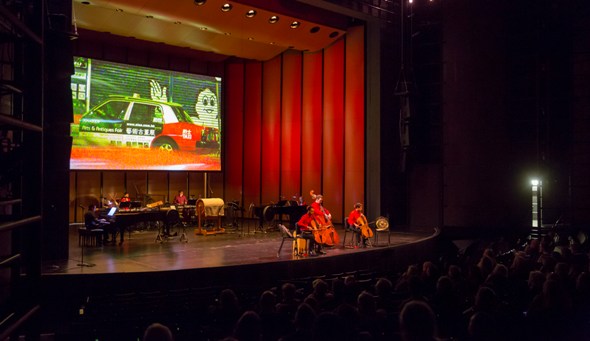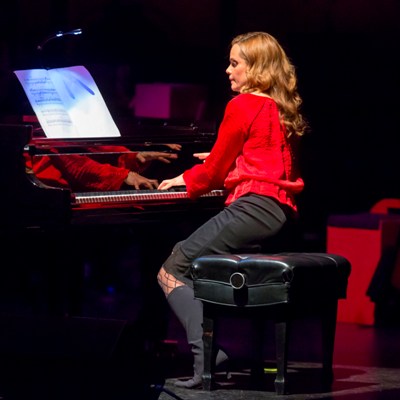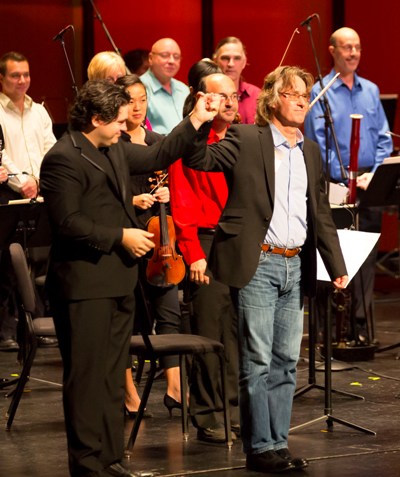Composers’ imaginative new worlds of sound infuse MusicNOW concert with energy, flair
 Review: MusicNOW concert, featuring compositions by Anders Hillborg, Donnacha Dennehy and Benedict Mason, conducted by Cristian Macelaru on Oct. 22 at the Harris Theater. ★★★★
Review: MusicNOW concert, featuring compositions by Anders Hillborg, Donnacha Dennehy and Benedict Mason, conducted by Cristian Macelaru on Oct. 22 at the Harris Theater. ★★★★
By Nancy Malitz
Concert photos by Todd Rosenberg
Donnacha Dennehy can take my ears on a ride any day. The last composition of his that I heard performed was “To Herbert Brun,” an ode to his legendary teacher, who obviously inspired in Dennehy a similar love for generating new sound worlds of striking psychological power.
 The Irish composer’s music begins with often simple beauty, a lulling timbral manipulation via computer of something that is otherwise familiar, and then you’re off on an experience as timeless and intense as a dream.
The Irish composer’s music begins with often simple beauty, a lulling timbral manipulation via computer of something that is otherwise familiar, and then you’re off on an experience as timeless and intense as a dream.
Dennehy’s 2007 work “Stainless Staining” was one of three compositions performed Oct. 22 at the opening concert of the Chicago Symphony Orchestra’s 2013-14 MusicNOW series — the others by Swedish composer Anders Hillborg and British composer Benedict Mason. MusicNOW is curated by the CSO’s two composers in residence, Mason Bates and Anna Clyne, and presented with aggressive theatrical flair four times a year at the Harris Theater of Music and Dance at Millennium Park.
The concerts have become musts for a new generation of Chicago music lovers, typically in their 20s and 30s, who are open to almost any musical experience, which they discuss afterwards in the theater’s wide hallways until the free beer and pizza run out, and maybe longer. The performers also hang around.
 At MusicNOW, Chicago Symphony players routinely perform in the ensembles alongside local free-lancers whose jobbing routines are far more eclectic. And the pieces are impeccably prepared — for this event by conductor Cristian Macelaru, who has been the go-to replacement conductor for the Chicago Symphony in recent seasons, especially when something unusual was on the program. Bates and Clyne, both thriving in their five-year CSO tenures, aggressively cross-sell upcoming events they think their listeners will love. (“Text CSONOW at 30364 for a chance to win free tickets for a great December concert with a piece by Bernard Rands down the street.”)
At MusicNOW, Chicago Symphony players routinely perform in the ensembles alongside local free-lancers whose jobbing routines are far more eclectic. And the pieces are impeccably prepared — for this event by conductor Cristian Macelaru, who has been the go-to replacement conductor for the Chicago Symphony in recent seasons, especially when something unusual was on the program. Bates and Clyne, both thriving in their five-year CSO tenures, aggressively cross-sell upcoming events they think their listeners will love. (“Text CSONOW at 30364 for a chance to win free tickets for a great December concert with a piece by Bernard Rands down the street.”)
Dennehy’s “Stainless Staining” is for piano (plucked and played) and electronically sampled piano (which sometimes sounds like hundreds). In a slickly produced pre-performance video — so much better than watching composers, who are often not performers, mumble — Dennehy explained his recent focus on the overtone series in combination with pulsating rhythms. In this case, the fundamental is a G-sharp well below the range of the piano, and the instrument itself is re-tuned to capture a massive harmonic spectrum of 100 naturally vibrating overtones purely, without the slightly bent tuning that allows for the modern piano to play equally well in any key.
 If you hear a pure fifth and an equalized fifth side by side, the latter will sound ever so slightly flattened and a tad less resonant, with an effect that feels more confined than, say, cathedral sound. We’re used to equalized sonorities, but for a purpose such as Dennehy’s the difference allows him to fabricate a vibrant acoustical chamber that sets even your bones into a steadily pulsating miracle of sympathetic resonance.
If you hear a pure fifth and an equalized fifth side by side, the latter will sound ever so slightly flattened and a tad less resonant, with an effect that feels more confined than, say, cathedral sound. We’re used to equalized sonorities, but for a purpose such as Dennehy’s the difference allows him to fabricate a vibrant acoustical chamber that sets even your bones into a steadily pulsating miracle of sympathetic resonance.
A single pianist — the seasoned new music specialist Amy Briggs, whose musical virtuosity extends to ping-pong balls — produced live amplified sounds, often insistent syncopations, from the stage. The rest flowed in from behind and around, building hypnotically. There’s seriousness of purpose to Dennehy’s work that made one want to adjust to its measured pace and to anticipate changes of timbre that became every more stunning toward the end.
The cumulative effect is that of one kind of energy inevitably spilling into another, like a horse effortlessly changing gaits and, in the natural course of things, going airborne. (The composition has been recorded.)
 If Dennehy’s work was wise, the other two works on the program were smart, with plenty of attitude. Benedict Mason’s new piece, a multimedia installation featuring 19 performers, was given a title in early program materials as “Delta River.” But in the printed programs on concert night, the name was an unexplained graphic (at right). What it means, I have no idea.
If Dennehy’s work was wise, the other two works on the program were smart, with plenty of attitude. Benedict Mason’s new piece, a multimedia installation featuring 19 performers, was given a title in early program materials as “Delta River.” But in the printed programs on concert night, the name was an unexplained graphic (at right). What it means, I have no idea.
Mason himself is wickedly funny. He used his video time to dis the usefulness of a far-flung trip to the Orient that for gathering his new composition’s film footage, which he said could just as well have been shot in a railroad station. The first images are of a toy kitty clock, ticking loudly, as the performers trickle in and set themselves up. The movie clips look deliberately homemade, with fun-house special effects, lots of quick forward-reverse and stop action of people in street markets, mirror image video, slo-mo, a cabbage monster (don’t ask) and other quirky shots.
 The sounds range from cheap pentatonic chinoiserie to some pretty terrific stuff, especially the echoing forest sounds on pitched wood, like a million crickets in riotous chorus, and the gathering sounds of nightlife generally, both human and feral. The performance featured six handmade instruments, created by CSO bassist and master woodworker Roger Cline. Their names cannot go unmentioned: multiple slapstick, clapper Matraca, enclosed ratchets, Triccaballacca, branch rattles and Hyoshigi.
The sounds range from cheap pentatonic chinoiserie to some pretty terrific stuff, especially the echoing forest sounds on pitched wood, like a million crickets in riotous chorus, and the gathering sounds of nightlife generally, both human and feral. The performance featured six handmade instruments, created by CSO bassist and master woodworker Roger Cline. Their names cannot go unmentioned: multiple slapstick, clapper Matraca, enclosed ratchets, Triccaballacca, branch rattles and Hyoshigi.
The program opened with a wonderful piece by Hillborg from 2010 — “Vaporized Tivoli” — which the composer said was inspired in part by a Ray Bradbury novel he read as a teenager called “Something Wicked This Way Comes,” about a traveling circus that comes to town and preys on its people.
 But Hillborg’s piece is not so much scary as it is genuinely diverting, then haunting. It starts with bright, scattershot energy and then bridges into a seductive rhythmic section that the composer, in his video, described as “an opportunity to channel your inner James Brown.”
But Hillborg’s piece is not so much scary as it is genuinely diverting, then haunting. It starts with bright, scattershot energy and then bridges into a seductive rhythmic section that the composer, in his video, described as “an opportunity to channel your inner James Brown.”
The deeply wary aftermath comes as a well-timed dramatic turn. Hillborg has a broad command of musical language and style, high and low, cerebral and popular. You can hear “Vaporized Tivoli” here. I am officially looking forward to what he writes for cellist Yo-Yo Ma and pianist Emanuel Ax, who have scheduled the new commission for their Chicago recital on Feb. 21, 2014, with subsequent performances at New York City’s Carnegie Hall, Los Angeles’ Disney Hall, and Berkeley’s Cal Performances.
Related Link:
More on the Chicago Symphony’s MusicNOW series: Download the brochure
Tags: Amy Briggs, Anders Hillborg, Benedict Mason, Chicago Symphony Orchestra, Cristian Macelaru, Donnacha Dennehy, MusicNOW, Roger Cline

